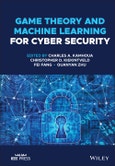Move beyond the foundations of machine learning and game theory in cyber security to the latest research in this cutting-edge field
In Game Theory and Machine Learning for Cyber Security, a team of expert security researchers delivers a collection of central research contributions from both machine learning and game theory applicable to cybersecurity. The distinguished editors have included resources that address open research questions in game theory and machine learning applied to cyber security systems and examine the strengths and limitations of current game theoretic models for cyber security.
Readers will explore the vulnerabilities of traditional machine learning algorithms and how they can be mitigated in an adversarial machine learning approach. The book offers a comprehensive suite of solutions to a broad range of technical issues in applying game theory and machine learning to solve cyber security challenges.
Beginning with an introduction to foundational concepts in game theory, machine learning, cyber security, and cyber deception, the editors provide readers with resources that discuss the latest in hypergames, behavioral game theory, adversarial machine learning, generative adversarial networks, and multi-agent reinforcement learning.
Readers will also enjoy: - A thorough introduction to game theory for cyber deception, including scalable algorithms for identifying stealthy attackers in a game theoretic framework, honeypot allocation over attack graphs, and behavioral games for cyber deception - An exploration of game theory for cyber security, including actionable game-theoretic adversarial intervention detection against advanced persistent threats - Practical discussions of adversarial machine learning for cyber security, including adversarial machine learning in 5G security and machine learning-driven fault injection in cyber-physical systems - In-depth examinations of generative models for cyber security
Perfect for researchers, students, and experts in the fields of computer science and engineering, Game Theory and Machine Learning for Cyber Security is also an indispensable resource for industry professionals, military personnel, researchers, faculty, and students with an interest in cyber security.
Table of Contents
Editor biographies
Contributors
Foreword
Preface
Chapter 1: Introduction
Christopher D. Kiekintveld, Charles A. Kamhoua, Fei Fang, Quanyan Zhu
Part 1: Game Theory for Cyber Deception
Chapter 2: Introduction to Game Theory
Fei Fang, Shutian Liu, Anjon Basak, Quanyan Zhu, Christopher Kiekintveld, Charles A. Kamhoua
Chapter 3: Scalable Algorithms for Identifying Stealthy Attackers in a Game Theoretic Framework Using Deception
Anjon Basak, Charles Kamhoua, Sridhar Venkatesan, Marcus Gutierrez, Ahmed H. Anwar, Christopher Kiekintveld
Chapter 4: Honeypot Allocation Game over Attack Graphs for Cyber Deception
Ahmed H. Anwar, Charles Kamhoua, Nandi Leslie, Christopher Kiekintveld
Chapter 5: Evaluating Adaptive Deception Strategies for Cyber Defense with Human Experimentation
Palvi Aggarwal, Marcus Gutierrez, Christopher Kiekintveld, Branislav Bosansky, Cleotilde Gonzalez
Chapter 6: A Theory of Hypergames on Graphs for Synthesizing Dynamic Cyber Defense with Deception
Jie Fu, Abhishek N. Kulkarni
Part 2: Game Theory for Cyber Security
Chapter 7: Minimax Detection (MAD) for Computer Security: A Dynamic Program Characterization
Muhammed O. Sayin, Dinuka Sahabandu, Muhammad Aneeq uz Zaman, Radha Poovendran, Tamer Başar
Chapter 8: Sensor Manipulation Games in Cyber Security
João P. Hespanha
Chapter 9: Adversarial Gaussian Process Regression in Sensor Networks
Yi Li, Xenofon Koutsoukos, Yevgeniy Vorobeychik
Chapter 10: Moving Target Defense Games for Cyber Security: Theory and Applications Abdelrahman Eldosouky, Shamik Sengupta
Chapter 11: Continuous Authentication Security Games
Serkan Saritas, Ezzeldin Shereen, Henrik Sandberg, Gyorgy Dan
Chapter 12: Cyber Autonomy in Software Security: Techniques and Tactics
Tiffany Bao, Yan Shoshitaishvili
Part 3: Adversarial Machine Learning for Cyber Security
Chapter 13: A Game Theoretic Perspective on Adversarial Machine Learning and Related Cybersecurity Applications
Yan Zhou, Murat Kantarcioglu, Bowei Xi
Chapter 14: Adversarial Machine Learning in 5G Communications Security
Yalin Sagduyu, Tugba Erpek, Yi Shi
Chapter 15: Machine Learning in the Hands of a Malicious Adversary: A Near Future If Not Reality Keywhan Chung, Xiao Li, Peicheng Tang, Zeran Zhu, Zbigniew T. Kalbarczyk, Thenkurussi Kesavadas, Ravishankar K. Iyer
Chapter 16: Trinity: Trust, Resilience and Interpretability of Machine Learning Models
Susmit Jha, Anirban Roy, Brian Jalaian, Gunjan Verma
Part 4: Generative Models for Cyber Security
Chapter 17: Evading Machine Learning based Network Intrusion Detection Systems with GANs Bolor-Erdene Zolbayar, Ryan Sheatsley, Patrick McDaniel, Mike Weisman
Chapter 18: Concealment Charm (ConcealGAN): Automatic Generation of Steganographic Text using Generative Models to Bypass Censorship
Nurpeiis Baimukan, Quanyan Zhu
Part 5: Reinforcement Learning for Cyber Security
Chapter 19: Manipulating Reinforcement Learning: Stealthy Attacks on Cost Signals
Yunhan Huang, Quanyan Zhu
Chapter 20: Resource-Aware Intrusion Response based on Deep Reinforcement Learning for Software-Defined Internet-of-Battle-Things
Seunghyun Yoon, Jin-Hee Cho, Gaurav Dixit, Ing-Ray Chen
Part 6: Other Machine Learning approach to Cyber Security
Chapter 21: Smart Internet Probing: Scanning Using Adaptive Machine Learning
Armin Sarabi, Kun Jin, Mingyan Liu
Chapter 22: Semi-automated Parameterization of a Probabilistic Model using Logistic Regression - A Tutorial
Stefan Rass, Sandra König, Stefan Schauer
Chapter 23: Resilient Distributed Adaptive Cyber-Defense using Blockchain
George Cybenko, Roger A. Hallman
Chapter 24: Summary and Future Work
Quanyan Zhu, Fei Fang








